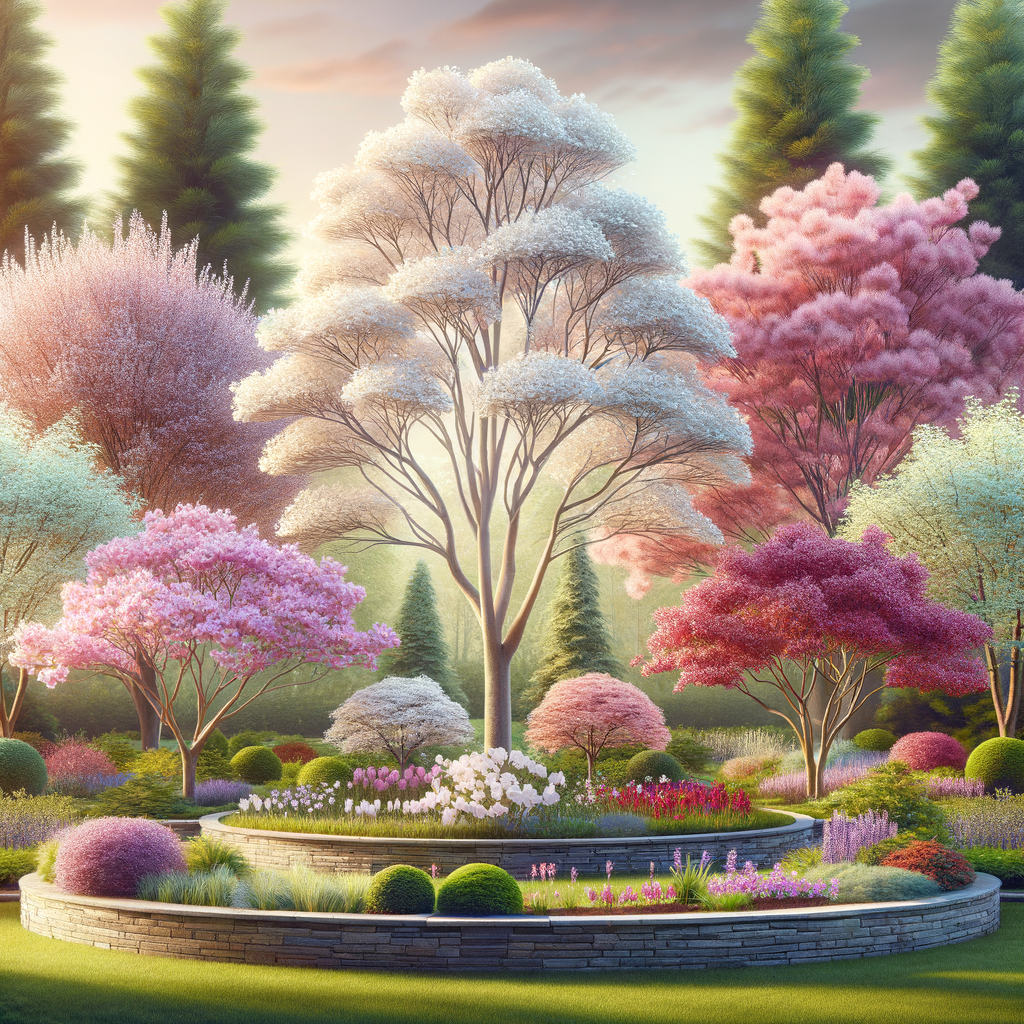
Introduction to Magnolia Substitutes
When it comes to landscaping, variety is the spice of life. While the magnolia tree is a popular choice for many homeowners, there are times when you might need or want to consider alternatives. In this section, we will explore the reasons for considering magnolia substitutes and the benefits they bring.
-
- Understanding the need for Magnolia Substitutes
There are several reasons why you might need to consider magnolia substitutes. For instance, you might live in a region where magnolias don’t thrive due to the climate or soil conditions. Or, you might simply want to add more diversity to your landscape. Additionally, some people might have allergies to magnolias, making it necessary to find alternatives.
-
- Benefits of considering Magnolia Tree Alternatives
There are many benefits to considering magnolia tree alternatives. Firstly, it provides an opportunity to diversify your landscape, making it more visually appealing. Secondly, different trees attract different types of wildlife, so by diversifying your trees, you can attract a wider range of birds and insects. Lastly, some alternatives might be more resistant to pests or diseases, reducing the need for maintenance and care.
In the following sections, we will delve deeper into the world of magnolia substitutes, exploring various options and how they compare to magnolias in terms of aesthetics, maintenance, and environmental impact. So, whether you’re a seasoned landscaper or a beginner, stay tuned for a wealth of information that will help you make informed decisions about your landscape design.
Exploring Landscape Design without Magnolias
While Magnolias are a popular choice for many gardeners, there are numerous other trees that can add beauty and diversity to your landscape. Let’s explore some of these alternatives.
Alternative Trees for Landscaping
There are many other trees that can make your garden look just as beautiful, if not more so, than Magnolias. Here are some options to consider:
-
Non-Magnolia Trees for Landscaping: Examples and Benefits
There are several non-Magnolia trees that can make your garden stand out. For instance, the Dogwood tree, with its stunning white or pink flowers, is a great alternative. It’s not only beautiful but also attracts birds and butterflies, adding more life to your garden.
Another great option is the Redbud tree. It’s known for its vibrant pink flowers that bloom in early spring. Plus, it’s a relatively small tree, making it a perfect fit for smaller gardens.
Both these trees are easy to care for and can withstand various weather conditions, making them a practical choice for any garden.
-
How to Choose the Right Alternative Garden Trees
Choosing the right tree for your garden depends on several factors. First, consider the size of your garden. Larger trees may not be suitable for smaller gardens, while smaller trees may not make a significant impact in larger gardens.
Next, consider the climate of your area. Some trees thrive in certain climates, while others may struggle. For example, the Redbud tree prefers warmer climates, while the Dogwood can tolerate colder temperatures.
Finally, think about the maintenance required. Some trees require more care than others. If you’re a busy person, you might want to opt for a tree that requires less maintenance.
In conclusion, while Magnolias are a great choice for any garden, there are many other trees that can add diversity and beauty to your landscape. Don’t be afraid to explore these options and find the perfect fit for your garden.
Landscaping with Magnolias vs Magnolia-free Landscaping
When it comes to landscaping, the choice of plants can dramatically affect the overall aesthetic and feel of the garden. One popular choice among gardeners and landscapers is the Magnolia tree. But how does a garden with Magnolias compare to one without? Let’s delve into this comparison.
-
- Comparing the aesthetics of Magnolia and Non-Magnolia Gardens
Magnolia trees are known for their large, fragrant flowers and glossy green leaves. They add a touch of elegance and sophistication to any landscape. A garden with Magnolias often has a classic, timeless appeal. The trees serve as a focal point, drawing attention with their stunning blooms.
On the other hand, a garden without Magnolias offers more flexibility in terms of plant selection. You can experiment with a wider variety of plants, each contributing to a unique aesthetic. A Magnolia-free garden can be just as beautiful, with the right combination of plants creating a diverse and vibrant landscape.
Ultimately, the choice between a Magnolia and a non-Magnolia garden comes down to personal preference and the specific requirements of your landscape.
-
- Case Study: A successful Magnolia-free Landscaping project
Let’s consider a real-life example of a successful Magnolia-free landscaping project. The Johnson family, living in a suburban neighborhood, wanted to redesign their garden. They preferred a low-maintenance landscape without Magnolias.
The landscaper they hired decided to use a mix of native plants, including ferns, wildflowers, and shrubs. These plants are known for their resilience and require less care compared to Magnolias. The result was a stunning, easy-to-maintain garden that perfectly suited the Johnsons’ lifestyle.
This case study demonstrates that a Magnolia-free landscape can be just as appealing and successful as one with Magnolias. It all depends on the specific needs and preferences of the homeowner, as well as the creativity and expertise of the landscaper.
In conclusion, whether you choose to include Magnolias in your landscape or opt for a Magnolia-free garden, both options can result in a beautiful and satisfying outdoor space. The key is to understand your own preferences and needs, and to work with a knowledgeable and experienced landscaper.
Magnolia Replacement Options: A Closer Look
While Magnolias are a popular choice for many gardeners, there are numerous other options that can offer similar beauty and charm. In this section, we will delve deeper into the alternatives to Magnolias, providing you with a comprehensive understanding of their growth patterns and key takeaways to help you select the right substitute for your garden.
Alternatives to Magnolia in Garden: Detailed Analysis
There are a plethora of trees that can serve as excellent replacements for Magnolias in your garden. Let’s take a detailed look at these alternatives and their growth patterns.
-
- Understanding the growth patterns of Alternative Garden Trees
Understanding the growth patterns of your chosen tree is crucial to ensure it thrives in your garden. For instance, Dogwoods, a popular Magnolia substitute, grow at a moderate rate and prefer well-drained soil and partial to full sun. On the other hand, Lilacs, another excellent alternative, are slow-growing and require full sun and well-drained soil. By understanding these growth patterns, you can ensure that your chosen tree will thrive in your garden’s conditions.
-
- Key takeaways: Choosing the right Magnolia Substitute for your garden
Choosing the right Magnolia substitute for your garden depends on several factors. These include the tree’s growth rate, its soil and sunlight requirements, and its overall appearance. Here are some key takeaways:
-
- Dogwoods are a great choice for those looking for a tree with a moderate growth rate and beautiful spring blooms.
- Lilacs, while slow-growing, offer stunning purple flowers and a delightful fragrance.
- Both trees require well-drained soil and plenty of sunlight, making them suitable for most garden conditions.
In conclusion, while Magnolias are indeed beautiful, they are not the only option for your garden. By understanding the growth patterns of alternative trees and considering your garden’s conditions, you can find a suitable Magnolia substitute that will add beauty and charm to your landscape.
Conclusion: Embracing Non-Magnolia Trees for Landscaping
As we wrap up our discussion on magnolia substitutes, it’s clear that the world of landscaping offers a vast array of options. Let’s summarize the key points and benefits of embracing non-magnolia trees for your landscaping needs.
-
- Summary of the Benefits of Magnolia Tree Alternatives
Non-magnolia trees bring a unique charm and diversity to your landscape. They are often more resilient to pests and diseases, reducing the need for chemical treatments. Many alternatives also offer longer blooming periods, providing your garden with a splash of color throughout more of the year. Additionally, these alternatives can better tolerate a range of soil types and weather conditions, making them a more flexible choice for various climates.
-
- Final Thoughts on Landscape Design with Magnolia Substitutes
Choosing to incorporate non-magnolia trees into your landscape design can open up a world of possibilities. From the vibrant colors of Dogwood trees to the towering elegance of Oak trees, each alternative brings its unique character to your garden. Remember, successful landscaping is about creating a balanced ecosystem that is both visually appealing and sustainable. By considering magnolia substitutes, you are expanding your horizons and creating a more diverse and resilient garden.
In conclusion, while magnolias are indeed beautiful and popular, they are not the only option. Embracing the diversity of the plant world will not only enhance the aesthetic appeal of your landscape but also its overall health and sustainability. As the old saying goes, “Variety is the spice of life.” So why not apply this wisdom to your garden as well?














